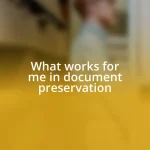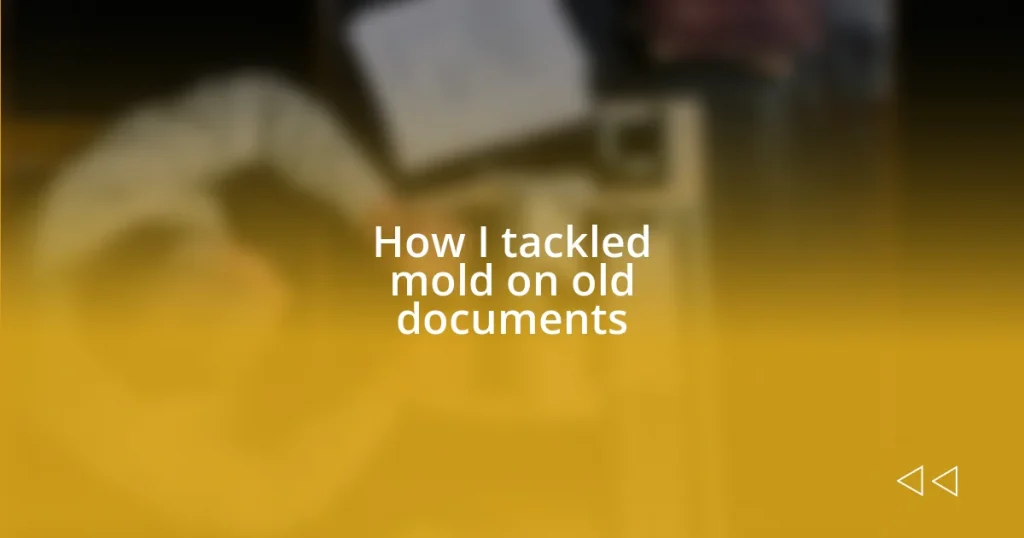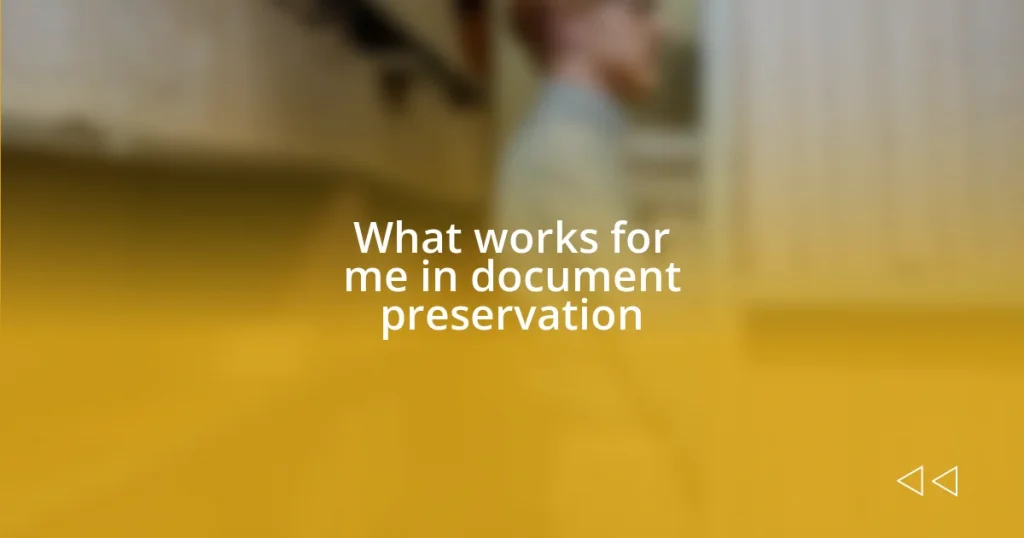Key takeaways:
- Mold thrives in damp, warm environments, making old documents particularly vulnerable; proper storage and cleaning methods are essential to preservation.
- Identify mold damage through signs such as fuzzy spots, musty odors, and damp textures, which can indicate the need for immediate action.
- For severe mold infestations, seeking professional conservation help can ensure the preservation of irreplaceable documents, utilizing specialized techniques for restoration.
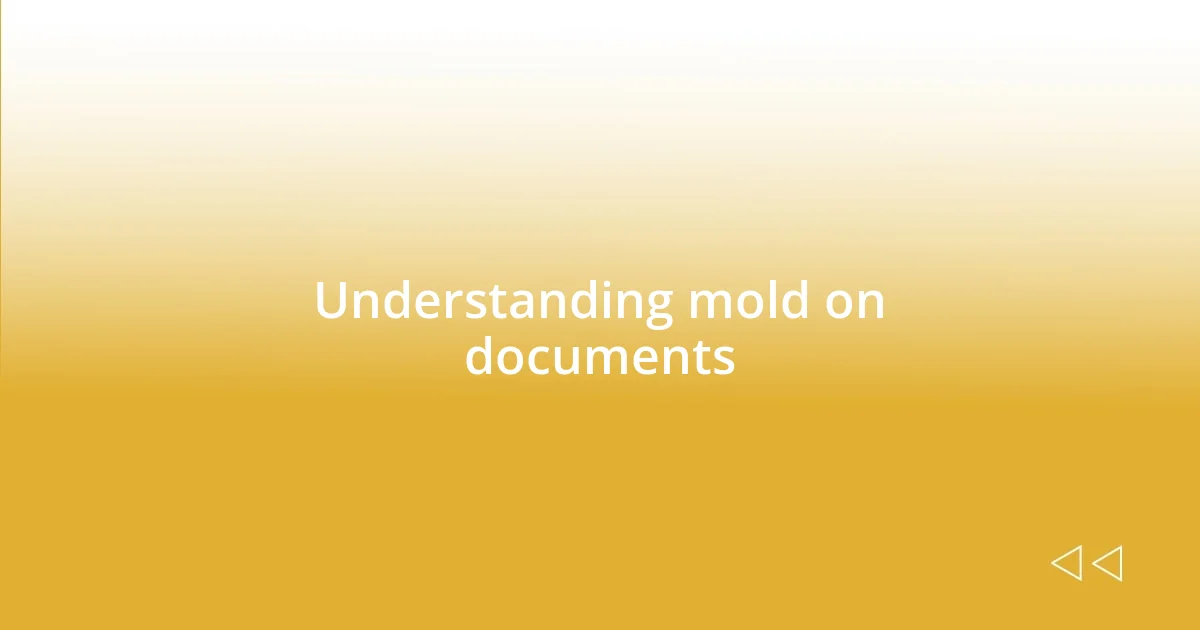
Understanding mold on documents
Mold thrives in damp, warm environments, which makes old documents particularly vulnerable. I remember the first time I discovered mold on a family heirloom – it felt like finding a ghost haunting my past. Have you ever held a piece of history in your hands, only to see it marred by something so insidious?
Understanding the factors that promote mold growth is essential. Humidity, poor ventilation, and organic materials all create a perfect storm for mold spores. I often wonder how many precious memories have been lost simply because of an overlooked environment.
The emotional weight of mold on documents can be profound. Each speck of mold represents a moment fading away. It can be a reminder of what we cherish – but also of our vulnerabilities. Have you felt that tug of nostalgia when considering the fragility of your memories stored on paper? It’s something worth safeguarding, for sure.

Identifying mold damage signs
Identifying mold on old documents can be complex, but several signs can help you spot it early. From my experience, one clear indicator is the appearance of fuzzy spots or discoloration on the surface. When I first encountered this on my grandmother’s letters, it felt like an immediate urgency to preserve those memories before they slipped away completely.
Another telltale sign is a musty odor. I recall sifting through old boxes and being hit by that distinctive smell — it was as if the documents were whispering their distress to me. You might wonder why that smell occurs. Mold releases spores and compounds that create that unpleasant scent, a reminder that something isn’t right in your storage space.
Finally, while surface-level signs are important, pay attention to the texture of the paper. Is it feeling damp or fragile? I once held an ancient book whose pages crumbled as I turned them, and that was my wake-up call. Each detail matters when it comes to preserving our history.
| Sign | Description |
|---|---|
| Fuzzy Spots | Indicators of mold growth; typically white, green, or black. |
| Musty Odor | A distinct smell caused by mold spores and compounds. |
| Damp Texture | Papers may feel moist or fragile, signaling mold presence. |
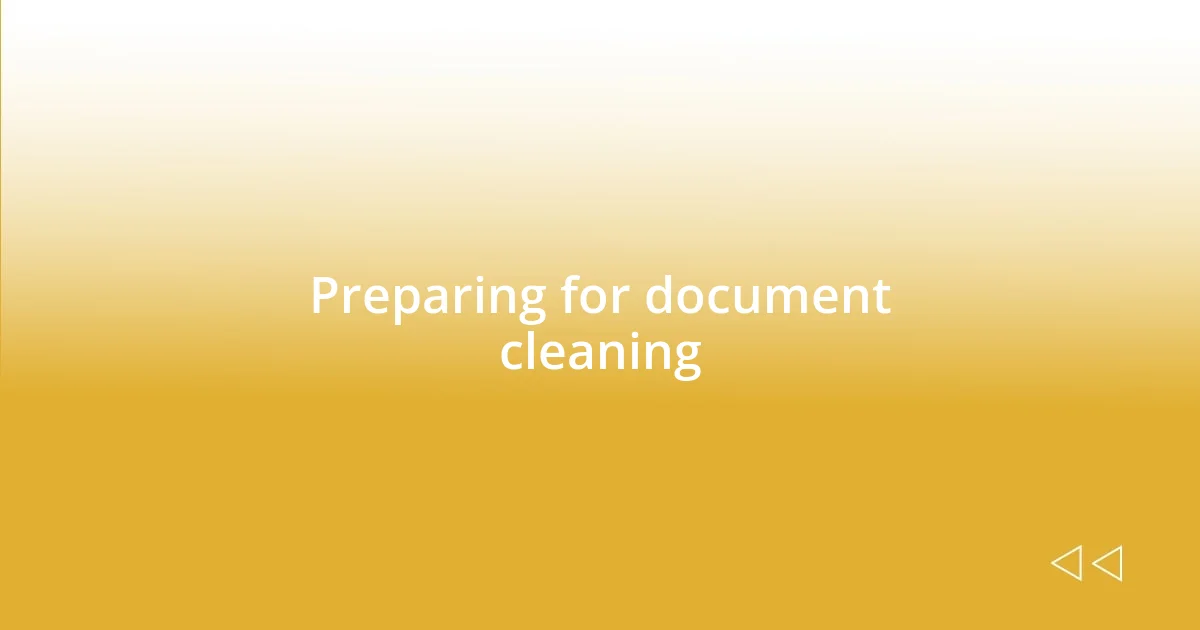
Preparing for document cleaning
Preparing to tackle mold on old documents requires a mindful approach. I often find it beneficial to create a dedicated workspace, one that is well-ventilated and dry. The last time I cleaned a treasured childhood journal, I transformed my living room into a mini conservation lab. It was a strange but exhilarating experience, knowing I was about to bring those cherished memories back to life.
Before you start cleaning, gather your supplies. Here’s what you’ll need:
- Soft brushes for gently removing surface mold.
- Cotton gloves to protect hands from mold spores.
- A face mask to avoid inhaling any spores during the process.
- Dehumidifiers or fans to facilitate drying the documents after cleaning.
- Archival-safe boxes or folders for storing the cleaned items.
This preparation not only minimizes risks but also sets a positive tone for the cleaning journey ahead. Sometimes, the act of preparing becomes just as important as the cleaning itself, as it gives me time to reflect on the importance of the documents I’m about to save.
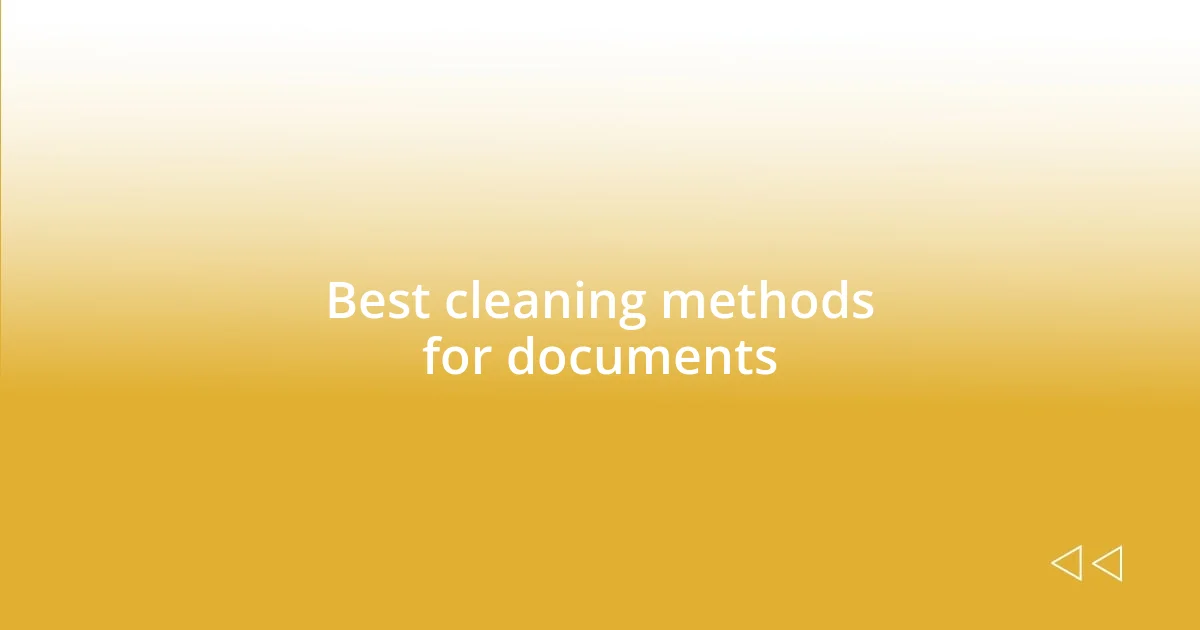
Best cleaning methods for documents
When it comes to cleaning mold off documents, I’ve found that a soft brush is often my best friend. There was a particularly dusty old map I had cherished; using a small, clean brush helped gently lift the spores without damaging the paper. It felt like I was delicately restoring a piece of history, and I couldn’t help but marvel at how a few gentle strokes could allow the original beauty to resurface.
For more stubborn mold, I sometimes resort to a specialized document cleaning solution. It’s important to test any product on a small corner first—trust me! I remember the panic of accidentally smudging ink while trying to clean an important letter. It taught me to work slowly and carefully, validating the adage that haste makes waste.
After cleaning, drying the documents becomes crucial. I use fans, but I also like to air-dry them flat on a clean, dry surface. I vividly recall laying out my grandmother’s recipes, feeling a sense of calm wash over me as her handwriting became legible once more. This step takes patience, but it’s the moment when you see your efforts pay off, creating a warm anticipation for the memories soon to be shared with family.

Proper drying techniques after cleaning
After I’ve cleaned the documents, I can’t stress enough the importance of proper drying techniques. One method I often use is laying the papers flat on a clean, dry surface, such as a towel or a large piece of uncoated cardboard. I remember the time I laid my vintage postcards this way; seeing them gradually dry felt like watching the life return to them. It’s mesmerizing how, with each passing hour, the colors began to pop again, slowly revealing the beauty that had been obscured.
Another technique I’ve found effective is using a fan to promote airflow. I position it at a safe distance, ensuring it doesn’t create too much wind that could disturb the fragile papers. In my journey of restoring an old diary filled with heartfelt entries, the gentle breeze from the fan reminded me of the whispers of the memories trapped within those pages, yearning to be shared. This method not only accelerates the drying process but also helps in preventing further mold growth, which is always a relief!
I’ve also experimented with a dehumidifier in my workspace, especially on particularly humid days. There was that one summer afternoon when the humidity was off the charts, and I felt like I was fighting a losing battle against mold. Once I set up the dehumidifier, I noticed how much more efficiently the documents dried. It’s these little tweaks that have made all the difference in preserving the past while keeping it safe for the future. What has your experience been with drying techniques?

Storing documents to prevent mold
Storing documents properly is as crucial as cleaning them when it comes to preventing mold. I’ve learned that keeping items in a cool, dry space makes all the difference. I vividly remember a time when I found a treasure trove of family letters tucked away in an attic. The nostalgia was priceless, but the musty smell reminded me of past mistakes. That’s when I realized the importance of a well-chosen storage area: a climate-controlled environment can be a game-changer.
When I store my documents, I always opt for archival-quality boxes and acid-free materials. This choice not only protects the paper but also helps control humidity levels. I can still picture the day I carefully placed my great-grandfather’s war letters in such a box. As I sealed it, I felt a weight lift from my shoulders, knowing those irreplaceable memories were far less likely to succumb to mold. Have you ever held the weight of history in your hands, only to worry about its preservation?
I also try to avoid direct contact with sunlight and keep the documents away from walls that can sweat or leak. One summer, I learned this lesson the hard way when I stored an old scrapbook too close to a window. The fading was heartbreaking, and I was left with the daunting task of trying to salvage those precious memories. It’s a reminder that strategic storage means not only safekeeping but also a commitment to honoring our past. Where do you store your valuable papers, and have you thought about how environmental factors play a role in their care?
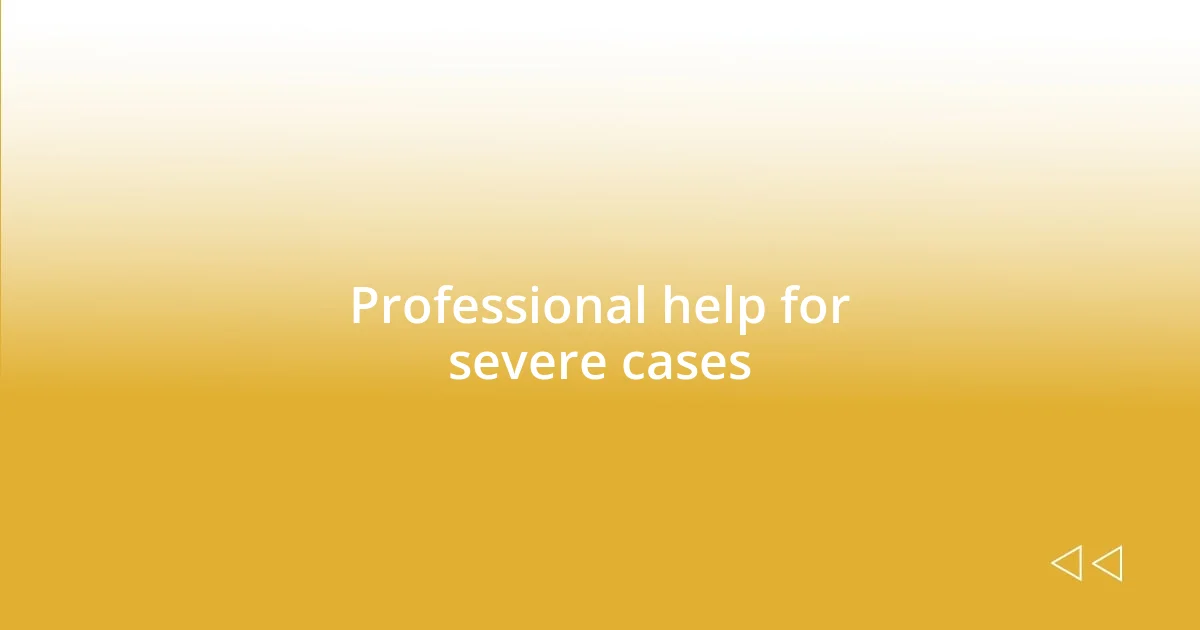
Professional help for severe cases
Sometimes, when mold infestation is severe, professional help becomes necessary. I recall a situation where a friends’ cherished family recipe book was nearly beyond saving. Despite her best efforts at cleaning, the mold had infiltrated the pages so deeply that she needed a professional conservator to restore it. Their expertise breathed life back into that book, allowing her to preserve her family’s culinary history.
Engaging with professionals can seem daunting, but I assure you, it’s a wise choice for significant cases. On one occasion, I encountered an old letter collection that had been subjected to moisture for years. The conservator not only cleaned and treated the mold but also provided insight into proper care and storage techniques moving forward. I often think about how daunting that first step felt, yet it ultimately opened a door to securing those precious documents for generations to come.
It’s reassuring to know that specialists have tools and knowledge that go beyond our everyday means. For instance, I was fascinated to learn about freeze-drying techniques; it was intriguing to witness such innovative methods in action. Have you ever found yourself in a similar bind, wondering if it might be time to seek help? Knowing when to call a pro can truly make all the difference in saving something irreplaceable.

